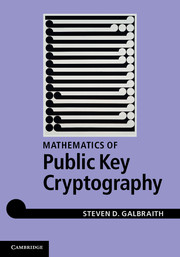Book contents
- Frontmatter
- Contents
- Preface
- Acknowledgements
- 1 Introduction
- PART I BACKGROUND
- PART II ALGEBRAIC GROUPS
- PART III EXPONENTIATION, FACTORING AND DISCRETE LOGARITHMS
- PART IV LATTICES
- PART V CRYPTOGRAPHY RELATED TO DISCRETE LOGARITHMS
- 20 The Diffie–Hellman problem and cryptographic applications
- 21 The Diffie–Hellman problem
- 22 Digital signatures based on discrete logarithms
- 23 Public key encryption based on discrete logarithms
- PART VI CRYPTOGRAPHY RELATED TO INTEGER FACTORISATION
- PART VII ADVANCED TOPICS IN ELLIPTIC AND HYPERELLIPTIC CURVES
- Appendix A Background mathematics
- References
- Author index
- Subject index
21 - The Diffie–Hellman problem
from PART V - CRYPTOGRAPHY RELATED TO DISCRETE LOGARITHMS
Published online by Cambridge University Press: 05 June 2012
- Frontmatter
- Contents
- Preface
- Acknowledgements
- 1 Introduction
- PART I BACKGROUND
- PART II ALGEBRAIC GROUPS
- PART III EXPONENTIATION, FACTORING AND DISCRETE LOGARITHMS
- PART IV LATTICES
- PART V CRYPTOGRAPHY RELATED TO DISCRETE LOGARITHMS
- 20 The Diffie–Hellman problem and cryptographic applications
- 21 The Diffie–Hellman problem
- 22 Digital signatures based on discrete logarithms
- 23 Public key encryption based on discrete logarithms
- PART VI CRYPTOGRAPHY RELATED TO INTEGER FACTORISATION
- PART VII ADVANCED TOPICS IN ELLIPTIC AND HYPERELLIPTIC CURVES
- Appendix A Background mathematics
- References
- Author index
- Subject index
Summary
This chapter gives a thorough discussion of the computational Diffie–Hellman problem (CDH) and related computational problems. We give a number of reductions between computational problems, most significantly reductions from DLP to CDH. We explain selfcorrection of CDH oracles, study the static Diffie–Hellman problem, and study hard bits of the DLP and CDH. We always use multiplicative notation for groups in this chapter (except for in the Maurer reduction where some operations are specific to elliptic curves).
Variants of the Diffie–Hellman problem
We present some computational problems related to CDH, and prove reductions among them. The main result is to prove that CDH and Fixed-CDH are equivalent. Most of the results in this section apply to both algebraic groups (AG) and algebraic group quotients (AGQ) of prime order r (some exceptions are Lemma 21.1.9, Lemma 21.1.15 and, later, Lemma 21.3.1). For the algebraic group quotients G considered in this book then one can obtain all the results by lifting from the quotient to the covering group G′ and applying the results there.
A subtle distinction is whether the base element g ∈ G is considered fixed or variable in a CDH instance. To a cryptographer it is most natural to assume the generator is fixed, since that corresponds to the usage of cryptosystems in the real world (the group G and element g ∈ G are fixed for all users). Hence, an adversary against a cryptosystem leads to an oracle for a fixed generator problem.
- Type
- Chapter
- Information
- Mathematics of Public Key Cryptography , pp. 418 - 451Publisher: Cambridge University PressPrint publication year: 2012

